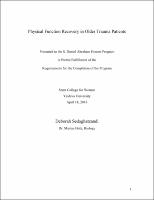Please use this identifier to cite or link to this item:
https://hdl.handle.net/20.500.12202/4061Full metadata record
| DC Field | Value | Language |
|---|---|---|
| dc.contributor.author | Sedaghatzandi, Deborah | - |
| dc.date.accessioned | 2018-11-05T20:30:03Z | - |
| dc.date.available | 2018-11-05T20:30:03Z | - |
| dc.date.issued | 2016-04 | - |
| dc.identifier.uri | https://hdl.handle.net/20.500.12202/4061 | - |
| dc.identifier.uri | https://ezproxy.yu.edu/login?url=https://repository.yu.edu/handle/20.500.12202/4061 | |
| dc.description | The file is restricted for YU community access only. | - |
| dc.description.abstract | Introduction: Older adults are the fastest-growing trauma population. At time of injury, most are living independently, but only 50% are discharged directly home. It is unclear how many patients return home or the level of recovery achieved. The aim of this study was to evaluate the functional recovery of the injured elderly over a period of 6 months. Methods: Data was prospectively collected on patients aged ≥55 years old, admitted to a level 1 trauma center after a traumatic event (eg, fall). Data included demographics, injury characteristics, and hospital course. A self-reported physical function measure (PROMIS-PF) was administered on admission, immediately post-discharge, and at 3 and 6 months post-injury to evaluate physical function. The PROMIS-PF score ranges from 20 to 100, and the minimally important difference is 4.0-6.0. Results: There were 202 enrolled patients; 10 withdrew and 6 died. Follow-up rates were 49% at 3 months and 53% at 6 months. Median age was 69.3 years. Fall was the leading mechanism of injury (86.1%). Of those sustaining injury (37% did not), the mean Injury Severity Score was 3.8(±4.5) and the majority (25.3%) had a primary orthopedic injury. Of those discharged alive, 45.5% were discharged home, 20.8% to a skilled nursing facility, and 5% to inpatient rehabilitation. On average, physical function scores decreased by 10(±16.6) percent immediately post-discharge. At 6 months, physical function scores were, on average, only 2(±15.5) points less than pre-injury and 77.6% had returned home. Conclusions: Injured older adults suffer functional decline. However, the majority experience near-complete recovery and return home by 6 months. Further work is needed 3 to evaluate the effect of injury pattern and discharge disposition on recovery after traumatic injury. | en_US |
| dc.description.sponsorship | S. Daniel Abraham Honors Program | en_US |
| dc.language.iso | en_US | en_US |
| dc.publisher | Stern College for Women | en_US |
| dc.rights | Attribution-NonCommercial-NoDerivs 3.0 United States | * |
| dc.rights.uri | http://creativecommons.org/licenses/by-nc-nd/3.0/us/ | * |
| dc.subject | Older people --Wounds and injuries --Treatment. | en_US |
| dc.subject | Older people --Wounds and injuries. | en_US |
| dc.subject | Traumatology. | en_US |
| dc.subject | Older people --Medical care --New York (State) --New York. | en_US |
| dc.subject | Older people --Rehabilitation --New York (State) --New York. | en_US |
| dc.subject | Physical therapy for older people --New York (State) --New York. | en_US |
| dc.title | Physical Function Recovery in Older Trauma Patients | en_US |
| dc.type | Thesis | en_US |
| Appears in Collections: | S. Daniel Abraham Honors Student Theses | |
Files in This Item:
| File | Description | Size | Format | |
|---|---|---|---|---|
| Deborah-Sedaghatzandi.pdf Restricted Access | 1.32 MB | Adobe PDF |  View/Open |
This item is licensed under a Creative Commons License

